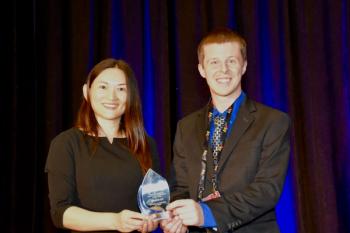
Breakthrough Reached in the Development of Solid Oxide Fuel Cells
Using synchrotron radiation and simulations via machine learning and thermogravimetric analysis, researchers at Kyushu University determined how to observe proton movement in perovskite-based electrolytes.
A research team led by Kyushu University has made a breakthrough in the development of solid oxide fuel cells (SOFCs) by uncovering the chemical inner workings of a perovskite-based electrolyte they developed for the cells (1).
To summarize the experiment, the research team combined machine learning, synchrotron radiation analysis, thermogravimetric analysis, and large-scale simulations to uncover the active site of where hydrogen atoms are introduced within the perovskite lattice in the process of producing energy (1). The results of the research were published in the journal Chemistry of Materials (1).
SOFCs generate electricity using hydrogen as fuel, with the only waste product being water (1). According to the researchers and other scientists, they could be a potential solution in reducing carbon output and mitigating the casualties of climate change (1). Although SOFCs have been commercialized in generators for single-family homes, they remain expensive and have a high operating temperature (1). Normally, conventional SOFCs require temperatures of 700–1000 ℃ for the electrolyte to perform efficiently (1).
Perovskites are a category of material with a specific crystalline structure that allows them to possess unique physical, optical, and electrical properties (1). They can be synthesized with different atoms, and a large body of research focuses on developing and testing a near infinite number of possible perovskites (1). As a result, perovskites may be able to develop better SOFC electrolytes that can operate at lower temperatures of around 300–450 ℃.
"In our past work, we developed a barium and zirconium-based perovskite with the chemical composition BaZrO3. By replacing the Zr site with a high concentration of Scandium, or Sc, we succeeded in making a high-performance electrolyte that can function at our target temperature of 400 ℃," explains Professor Yoshihiro Yamazaki at Kyushu University's Platform of Inter-/Transdisciplinary Energy Research, who led the research (1).
The team conducted X-ray absorption spectroscopy experiments on their perovskite electrolyte using synchrotron radiation while the fuel cell was active at approximately 400 ℃. The goal of doing this was to investigate the inner workings of SOFCs and learn more about them (1).
"These results gave us insight into where in the material's chemical structure the protons would be incorporated. From there we applied machine learning, and using a supercomputer calculated possible structural configurations of the material," continued Yamazaki (1).
The research has clarified the structural changes the electrolyte undergoes when active, providing insights that could lead to the optimization of its nanostructures and the proposal of new materials that can lead to more efficient fuel cells, and even ones that work at wider temperature ranges (1).
"Now that we have the fundamental innerworkings of the electrolyte we can being optimizing its nanostructures and even propose new materials that can lead to more efficient fuel cells, and even ones that work at wider temperature ranges," concludes Yamazaki (1).
In summary, a research team at Kyushu University used synchrotron radiation and simulations via machine learning and thermogravimetric analysis to study SOFCs (1). The researchers believe that their research has led to insights into how energy is produced inside perovskites, which can ultimately lead to the development of more efficient fuel cells, which, in turn, could be used to help combat the climate change phenomenon currently ongoing on Earth (1).
Reference
(1) Hoshino, K.; Kasamatsu, S.; Hyodo, J.; Yamamoto, K.; Setoyama, H.; Okajima, T.; Yamazaki, Y. Probing Local Environments of Oxygen Vacancies Responsible for Hydration in Sc-Doped Barium Zirconates at Elevated Temperatures: In Situ X-ray Absorption Spectroscopy, Thermogravimetry, and Active Learning Ab Initio Replica Exchange Monte Carlo Simulations. Chem. Mater. 2023, 35 (6), 2289–2301. DOI:
Newsletter
Get essential updates on the latest spectroscopy technologies, regulatory standards, and best practices—subscribe today to Spectroscopy.




